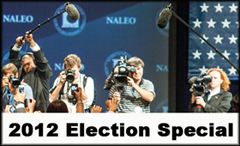While many college students were out celebrating — or mourning — the results of the election, nearly 80 University of Florida undergraduates covered the election live, based out of the College of Journalism and Communications’ new Integrated News Facility.

The INF, which opened in August, is the new home for the college’s news, weather and sports operations, and marks the first time the college’s television, radio and web newsrooms are all in the same space. This two-story, 12,000-square-foot space replaced three 1980s-era newsrooms and provides nearly 100 seats for reporters, producers and editors, all under the supervision of professional news managers.
That evening, UF students produced nearly three hours of live radio and TV content, broadcast on the 100,000-watt NPR-affiliate Florida’s 89.1 WUFT-FM, the 20,000-watt repeater station WJUF 90.1-FM, PBS-affiliate Florida’s 5 WUFT-TV and WRUF-TV, the 24/7 news/weather/sports station based at the college. Students also were live blogging on WUFT.org, creating 61 posts between 8 and 11:30 p.m.
New Opportunities
Election night was one of the first tests of this new space.
UF has a long history of using its television and radio properties to cover elections and breaking news. In 2010, the College used the newly constructed 21st Century News Lab to deliver a one-off converged coverage event, but the 2012 election presented the first time to test our multi-platform coverage of breaking news after we moved into the same space.
 During the academic terms, our students produce a one-hour news-feature radio program that airs before “All Things Considered,” as well as a nightly half-hour TV news show aired at 5 p.m. on our PBS affiliate, both as part of our telecommunication curriculum. Students also anchor news during “Morning Edition,” tape news cut-ins for WRUF-TV and do hourly news and sports updates for the radio stations. This semester, we are also able to provide a similar experience for our journalism majors who report and build out content for a more robust WUFT.org.
During the academic terms, our students produce a one-hour news-feature radio program that airs before “All Things Considered,” as well as a nightly half-hour TV news show aired at 5 p.m. on our PBS affiliate, both as part of our telecommunication curriculum. Students also anchor news during “Morning Edition,” tape news cut-ins for WRUF-TV and do hourly news and sports updates for the radio stations. This semester, we are also able to provide a similar experience for our journalism majors who report and build out content for a more robust WUFT.org.
The Rope Model
No longer are students learning to report one platform at a time. We have “print” students who not only write their stories but also record audio interviews to feed to the radio product, or cut their own audio features. Radio reporters pull audio from video they shot, use it on air and then turn around an online video telling the story in a different way. Or reporters go out on a television piece then turn a radio report on the same topic using much of the same content. Most of our introductory radio reporters are now snapping rudimentary cell phone photos for inclusion in the online versions of their stories, sent back to Web producers (and editing lab students) who are transforming broadcast scripts to online text.
We call this methodology the ROPE model – report once, publish everywhere.
Sure, we occasionally do still send out teams of reporters, especially on big news events; however, we try to create the same type of real-world expectations that our graduates find when they leave UF — preparing them to work for any type of media organization, despite their departmental affiliation.
Lessons Learned
The shift into the INF and using the ROPE methodology has not been without its hiccups.
The biggest vulnerability is that each platform – radio, TV and Web – has its own editorial content management system. ENPS, WordPress and KLZ Newsroom are all deployed, and none speak to the others.
 As a temporary work-around, we have created a networked drive that we call the “NewsVault” that allows us to avoid passing content via e-mail, FTP or USB drives.
As a temporary work-around, we have created a networked drive that we call the “NewsVault” that allows us to avoid passing content via e-mail, FTP or USB drives.
We are also using Google Docs spreadsheets to create a universal assignment sheet tracking stories, who is reporting them, and which assets or modalities those reporters are collecting.
One of our next big projects will be to find — or build — a content management system that works for all the platforms.
It is also easy to fall back into old habits.
One of the reasons we gave this space the “integrated” moniker instead of “converged” is because very often, converged newsrooms became co-located. The properties were in the same space, but they operated as separate entities.
On election night, as the reporting grew more intense and information came flying in, we did fall into that trap. Yes, many of our reporters in the field did call in to do live radio and TV reports – and Web reporters pulled information from that audio. But each distribution medium often acted on its own. We did not have centralized supervision of information, so there was no way to monitor which platform was releasing what or that our platforms were distributing the same information.
With 20 reporters in the field, TV and radio studios two floors away from the INF, and no easy way of communicating with each space, it was certainly understandable we fell into old habits, but that’s something we aim to work on.
Marching Toward the Future
Positively, the students have been very receptive to this new era for news at UF.
At first we all – especially the veterans – cast a wary eye at “those people” from the other platforms we are now sitting next to, but after a semester we have become closer to being one team.
 Events like the election prove why this project is so important.
Events like the election prove why this project is so important.
“Being here and being able to be a part of the information gathering – instead of sitting home watching my TV and getting this information, I’m producing this information,” said Kelly Price, a sophomore journalism major. “This is why I want to do what I want to do.”
“The urgency of the information being updated was something that I don’t think many of us students have had a chance to practice with,” said Emily Burris, a senior telecommunication major. “I think this was an excellent experience to see what news stations do for this type of special event coverage.”
As the final results came in, we could see the dedication these students had.
It was nearly 1 a.m. and the newsroom was slowly emptying. Some of the students were milling around the producer pods, perhaps experiencing the post-breaking news “high.”
Some would head home, or out to the bars. Others would rest a few hours only to return to anchor “Morning Edition” at 4:30 a.m.
Photos by Steve Johnson
Matt Sheehan is the director of the 21st Century News Lab at the University of Florida College of Journalism and Communications. Sheehan joined the college after two years in the media startup world, where he served as chief operating officer for a niche media company. A journalist and MBA, he’s served as an assistant news editor at The Washington Post, worked at a few other East Coast newspapers (as an editor, reporter, designer and online producer), and was an academic administrator at the University of Maryland’s Philip Merrill College of Journalism, where he also taught visual journalism.

